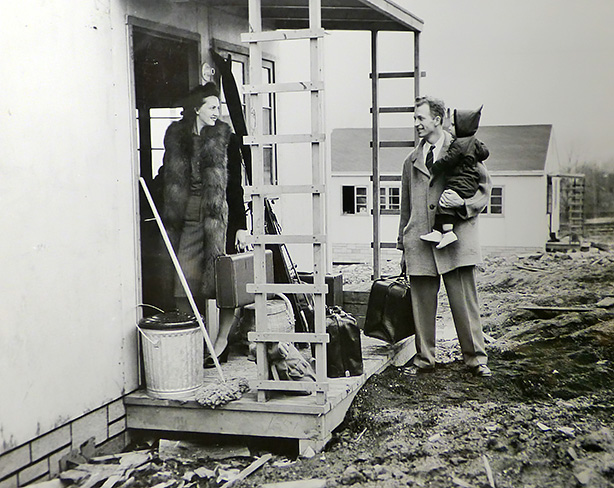
A couple moves into a "Vetsburg" cottage for married students, 1946. Photo: Division of Rare and Manuscript Collections.
New film, book explain G.I. Bill's effect on Cornell's Class of 1950 and on higher education
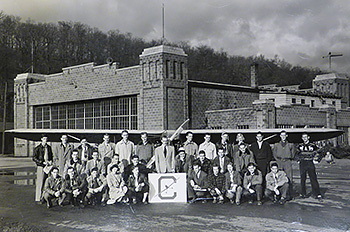
Group photo of the Cornell Pilots Club, 1948. The municipal airport hangar behind them became the home of Ithaca's Hangar Theatre in 1975. Photo: Division of Rare and Manuscript Collections.
On June 6 during Cornell's 2015 Reunion Weekend, members of the Class of 1950 gathered in Willard Straight Hall Theatre to watch their own story.
As other -- mostly younger -- classes enjoyed afternoon tent receptions, tours and concerts on a beautiful afternoon, members of Cornell's "Class of the Century" settled into the dark theater to watch "Cornell: Class of 1950," a new documentary commissioned by members of the class and created by Brian Frey of Binghamton public television station WSKG, about the lasting impact of the G.I. Bill on their class and the course of U.S. higher education.
I'm a part of this
The four years these Cornellians spent in college, from 1946 to 1950, were "a major period of change for education and for Cornell," says Stan Rodwin '50, class vice president and reunion chair.
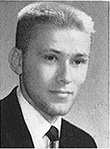
Stan Rodwin '50.
Through interviews, photos and archival footage, the film tells a story that started on the first day of classes: "On a warm and sunny fall afternoon in 1946, East Hill in Ithaca once again sprang to life."
Men returning from World War II ballooned Cornell's enrollment, as they did in colleges and universities across the country; the U.S. Servicemen's Readjustment Act of 1944, commonly known as the G.I. Bill of Rights, signed into law by President Franklin D. Roosevelt, offered returning veterans job training, unemployment pay, loan guaranty for homes, farms, or businesses, and college tuition and training.
Nearly two-thirds of the 10,000 students who enrolled at Cornell for the fall 1946 semester were WWII veterans. Raised during the Great Depression, they had witnessed death and devastation and were eager to move forward. Many were the first in their families to attend college -- and had had no such aspirations before the G.I. Bill presented the opportunity. In 1940, the film points out, only 15 percent of American high school graduates enrolled in college.
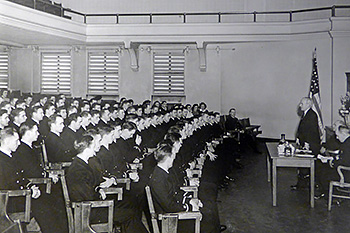
President Edmund Ezra Day addresses a group of cadets during World War II. Photo: Division of Rare and Manuscript Collections.
"Our education was pretty much [complete] if we had a high school education," Nick Sawicke '50 says in the film. "My parents didn't have the finances for college. And, as a rule, the farmers wanted their children to stay and help."
Sawicke's story captivated filmmaker Frey.
"It was the story of a kid who was poor," he said, "who never thought he'd have a chance to go to school, who had a horrific experience during World War II." It was by chance, Frey said, that a friend drove Sawicke to Cornell, where he was accepted.
"I feel honored," Sawicke says at the end of the film. "I'm a part of this. I'm glad I am. I hope I added something to it."
A tiger by the tail

Stan Rodwin '50 accepts the 2015 William "Bill" Vanneman '31 Outstanding Class Leader Award at the Cornell Alumni Leadership Conference in Boston in January 2015. Photo: University Photography file photo.
The G.I. Bill had a major impact on who and how many went to college, Frey said, effectively democratizing higher education at universities all over the country.
Frey makes films with local and regional interest but looks particularly for stories, like this one, that could appeal to a wider audience.
"I wanted to use Cornell to represent how many colleges and universities changed around this time and had students who took advantage of the G.I. Bill," he said. "Because of that, it started to change American education."
"Cornell: Class of 1950" will air (possibly with a different title) on public television stations throughout New York state and the northeast in August.
"It's a wonderful gift to Cornell," said Jack Rose '50, who appears in the film and attended the June 6 premiere.
Sixty-one members of the Class of 1950 returned for the Reunion 2015 (setting a 65th reunion attendance record). Each class member at Reunion received a DVD of the film, along with a 200-page hardcover book, "Curfews, Chaos, and Champions," by Ithaca author Brad Edmondson '81.
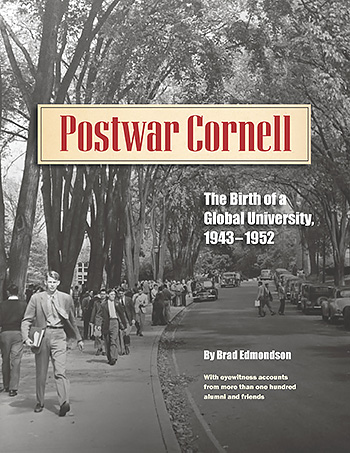
Brad Edmondson's book will be revised and published later this summer under a new title, "Postwar Cornell: The Birth of a Global University, 1943-52." Visit www.bradedmondson.com for more information or to pre-order.
Creating a film in honor of the class's 65th reunion started as a book project, said Rodwin. A few years ago, he and classmates Marion Steinmann and the late John Marcham decided a book about the dynamic period during which they attended Cornell would inform and inspire later generations.

Marion Steinmann '50.
The three already had a wealth of material among them. Steinmann had been collecting data and memorabilia from classmates, compiling two bound volumes. Marcham had edited the Cornell Alumni News for three decades. Rodwin, a longtime class officer who was recognized with the 2015 William Vanneman '31 Outstanding Class Leader Award, coordinated the project and provided driving enthusiasm.
They asked Edmondson to write a book and funded the project from the "Century Club Fund," funded by donations from class members.
"Stan and [Class of 1950 president] Pat Stewart understood that we really had a tiger by the tail here," said Edmondson. "We were really onto something good."
As Edmondson's book grew longer and deeper, Rodwin realized a live presentation for Reunion weekend could bring the book to life for class members. Right around this time, he received Frey's film "Cornell: Birth of the American University" as a gift and knew immediately that he'd found his filmmaker.
Frey joined the project enthusiastically and started coordinating with Edmondson right away. "It's a thrill for me to tell the story of your generation," Frey said at the June 6 screening.

The Class of 1950's logo.
Hopes for a wider audience
Although his book was commissioned and funded by the Class of 1950, author Brad Edmondson would like his story to reach a younger audience, and is revising his book into a second edition that will go on sale later this summer at www.bradedmondson.com. Similarly, Frey hopes that the film reaches a national public television audience after it is broadcast on regional PBS stations.
Rodwin plans to give the film and book to the university archives where, he hopes, they will inform and inspire current and future Cornellians. A few days after Reunion, he received a letter from President David Skorton, thanking him for the gift to the university.
"I look at it as a historical legacy," Rodwin said.
At the premiere, his classmates watched the film of their time at Cornell with rapt attention. "It brought tears to their eyes," Rodwin said. "I think it was more than anybody expected."
The lights came up. As class members rose from their seats to exit the theater (recently named for the Class of 1950), someone said to Rose, "Now you're a movie star!"
"I burst out laughing," Rose recalled.
A star, maybe not, but an important voice in American history captured on film, most definitely.
G.I. Bill continues to benefit Cornell student-veteransThe G.I. Bill of Rights has been updated twice since it made an impact on higher education in the 1940s and 50s. It still benefits military veterans in its current form, known as the Post-9/11 G.I. Bill. In a 2014 count, 117 students were receiving tuition assistance under the bill, which supports veterans with active service after Sept. 10, 2001 (and their spouses and dependents). After serving as an engineer officer in the US Army 2006-13 -- two tours of duty that took her to southern Iraq, Afghanistan, and Germany -- Jessie Sloan, MBA '16, decided business school would be a natural transition from the military to a civilian life and career. She is attending Cornell's Samuel Curtis Johnson Graduate School of Management on the Post-9/11 G.I. Bill. Johnson, with its focus on leadership, has a particularly strong veteran community. During the 2014-15 school year, 39 veterans and one descendant of a veteran used G.I. Bill benefits to attend Johnson. "The G.I. Bill helps give veterans the freedom to take risks," said Sloan, who funded her undergraduate studies at Boston College with an ROTC scholarship. In his Cornell application essay, Seamus Murphy '16 compared and contrasted his two deployments with the U.S. Army. His first deployment -- 15 months in Iraq during the 2007-08 surge -- had him going door to door with U.S. Marines in Ramadi, looking for insurgents and snipers, mortars and explosive devices. He lost a close friend to a suicide bomb attack but re-enlisted anyway, hoping a second tour of duty would allow him to use his promotion to staff sergeant to "keep my guys safe" by making a difference to the men he led one life at a time. He said he accomplished his goal. He also got into Cornell, a step he'd never dreamed of as a self-described "knucklehead" in high school. He's studying international agriculture and rural development in the College of Agriculture and Life Sciences on the Post-9/11 G.I. Bill. He's also benefitted from the U.S. Department of Veterans Affairs' Yellow Ribbon Program, a supplement to the Post-9/11 educational benefit that further defrays the cost of higher education for military veterans. |
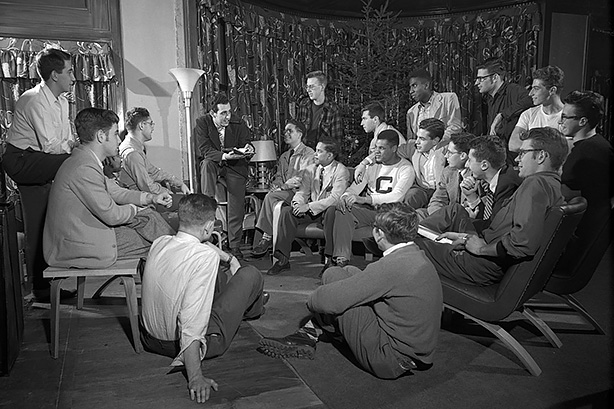
A Cornell Watermargin group meeting, around 1950. Photo: Division of Rare and Manuscript Collections.